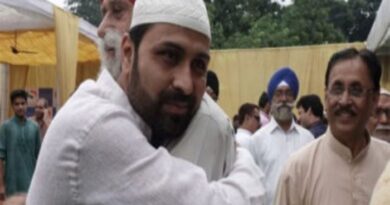A dreadful trail, of a dreaded past….
Like us on FB page, Share, subscribe, Follow us…be the voice of Free Press!
By Nazarul Islam, Copy Edited by Adam Rizvi, TIO: Our dreaded diseases may fully recede one day, however, the scars of memories shall not. One of the more terrible outcomes of the recent abominable pandemic was the isolation of those infected, often in a hospital ward, amid unfamiliar surroundings and with unknown people, without a loved one to touch, talk, and comfort. For every death recorded as a pandemic statistic, many more were emotionally distressed, indeed torn apart.
Families have continued to live with memories that will haunt them for a lifetime—of not being present at the time of death of their loved ones.
Also Read: Dehumanization Attempts Of Hijabi School Girls in India Find Support Across USA
But even before the pandemic, this kind of death, in a remote location, amid the cold steel of an ICU bed and away from home, had been invading our society. It has, in fact, become so common these days that nations have set up Commissions to study it and recommend a new protocol.
Death and dying had been suddenly moved from a family and community setting to primarily, the domain of existing health systems. Futile or even potentially inappropriate treatment was allowed to continue into the last hours of the victim’s life. The roles of families and communities had receded as though death and dying had become strangers, and skills, traditions, and knowledge were totally lost.
Also Read: Trigs on Track-Diplomacy Unwound -The Ukrainian Crisis
Death and dying had tilted the balance, unpredictably in high-income countries, and increasingly so, in low-and-middle-income countries.
Our stories shall be told and retold by the coming generations. Our tales are bringing to light precisely what palliative care teams have been struggling to highlight—how a highly ‘clinical’ death, a lingering push by modern technology and our system’s specialized and skilled doctors had mandated to “do everything”, often by prolonging the inevitable end of so many lives.
Also Read: Kashmir Files – Bloodied and Gory, Sold out to RSS/BJP Agenda
Obviously, this had come at a huge cost not only in terms of medical bills but also in terms of the comfort of the patient. It had robbed the dying and their loved ones of dignity and of opportunities for quiet moments that were needed together along with reflections, apologies, blessings, and the peace of having been close as they were allowed to part forever.
The critical prerequisite for all this to happen is the real, ability to accept death as the inevitable consequence of life.
Also Read: Diversity, not Divisiveness is the goal for secular India
We had developed this ability not too long ago. As recently as two generations back, people used to understand and breed familiarity with death. People used to die in their homes. Elders were familiar with the signs of dying, the changing nature of breathing, the limbs getting cold, and sometimes the painful rattling in the throat.
Extended families had found this precise moment to pray together, achieving not only some spiritual solace but also experiencing togetherness and the values of a fond farewell.
Also Read: Helping Women Get off Sex Trade
All this has changed and is now changing for more and more people. This truly creates a paradox in the modern medical system, as pointed out by those who have studied the subject. While many people are over-treated in hospitals with so many families and communities relegated to the margins, still more linger on remaining under-treated, or continue dying of preventable conditions—without access to basic measures of relief from pain.
This is indeed a painful picture of death and the dying are now sharing the tale of a society, which was put out of balance; to have been lost in modern medicine, unmindful of where all this would ultimately take us. It had turned death into a scary prospect, that certainly is not intended as a happy way to go.
Also Read: India: Gangster Capitalism Financing Criminals in Politics & Sham Democracy
The change from dying at home to dying in a hospital has been a paradigm shift, in the countries of the Indian subcontinent, with its fairly recent origin. Even in the 1990s, intensive care was meant for those with a reasonable chance of getting back to a reasonable quality of life. That has changed, for good. In a short span, Healthcare had become the healthcare industry. It also became high-tech. The industry created protocols. If the oxygen saturation or the sodium level dropped, as it inevitably had to in a dying person, the person was to be shifted to the ICU. This, of course, meant separation from the family.
Also Read: Trigs on Track- Diplomacy Unwound – Wintering the Beijing Olympics
The dying person was fitted with scary tubes taped to the veins and mouth and nose to ensure that even during the five minutes of entry into the ICU, the family was afraid to touch the affected person. No longer did we believe in any healing touch nor any healing words that the family could carry as memories for the rest of their lives. The grief had left raw wounds which would never heal, particularly impacting the emotional health of adolescents and the children—all combined together, sharing a common fate of grief.
There was, of course, no question of what was treatable or what was needed to be treated. Hospitalization cannot be ruled out as a norm —for, that would be disastrous. But it has also called for a careful assessment of the health condition of the patient so that the hospital is not the unconsidered, natural, and inevitable destination for everyone who is ailing and has little time left.
Also Read: Redefining Hindu identity in America
In the post-pandemic world, we have discussed the importance of human connections and community involvement during the time surrounding end-of-life. Also, we have shared in-depth the consequences of irrational over-medicalization of death which has already been normalized by the medical system during the last quarter of a century.
The proposed solutions are many, but fundamental to them happens to be the need for discussions within families and communities. The commissions laud the palliative care networks which support people dying, caring, and grieving, and call for conversations on death, dying, and grief.
Also Read: Groom Arrested! Hindutva is engulfing Little Traditions of India.
Obviously, these are difficult conversations. Not all doctors are equipped to help or advise here. Only well-trained palliative care professionals can respond effectively by looking for a balance and guiding family members, who themselves would be in a state of confusion and struggling to respond and cope with the situation.
Rather clearly, the value of time increases dramatically when someone suffers from an incurable disease. Compared to a young person with a reasonable chance of living a life of an average expectancy of 70 years, every hour is so much more precious for the person with only days, months, or years to live. At this stage, any life-prolonging treatment has to be balanced against the quality of life.
Also Read: Trigs on Track-Diplomacy Unwound : The Central Connect
The person has to be treated for pain or any other distressing symptoms and made comfortable with palliative care. Anxiety, depression, anger, guilt, or other emotional issues need to be brought out into the open and resolved. The person’s remaining time is precious, therefore needs to be filled with love, dignity, and meaning.
A writer I happen to know has shared that death is not always benevolent and beautiful. I believe that. When the physical suffering in people with diseases like cancer was extreme, no philosophizing, compassion, or companionship helped enough. The suffering was excruciating. People just stood watching helplessly…(yet) the dying person and the family members were never alone in their suffering or grief.
Also Read: Where lies the priority—Humanity or Religion?
Relief from pain has come from palliative care, but comfort always has been the net outcome of dedicated, loving, family care. These are lessons that can hopefully be taken to heart and can be spread across our brothers and sisters in India. Bangladesh and Pakistan, where the last Covid-19 pandemic has highlighted the horrors of separation at the time of death.
Curated by Humra Kidwai.




